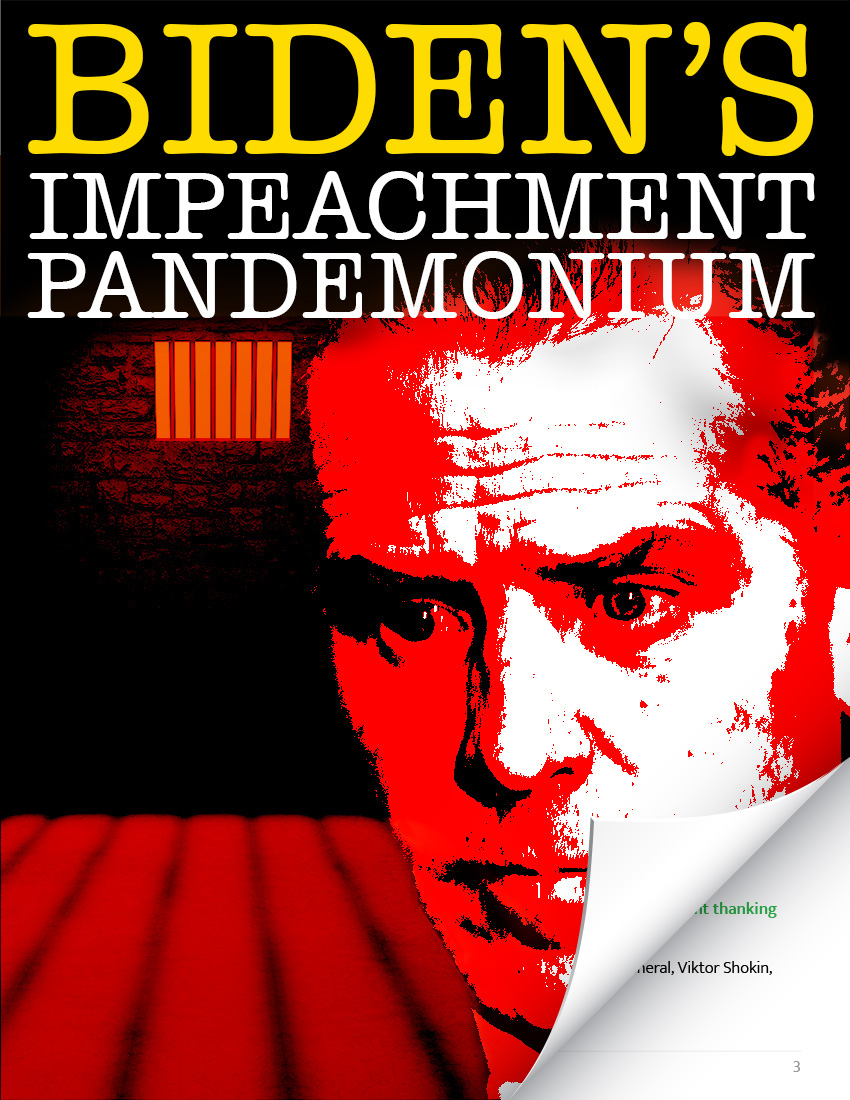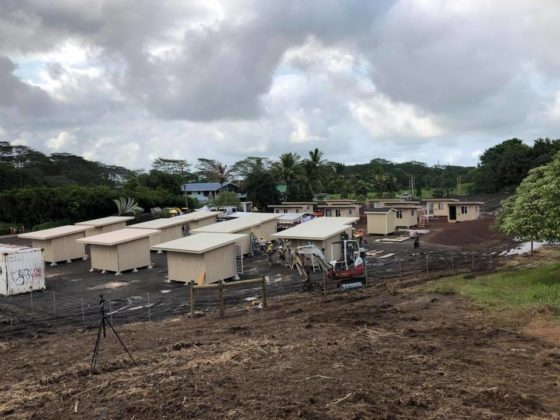
TRUMP SAYS: HUNTER MAKES FORTUNE FROM SHADY DEALS!
BIDEN FAMILY STINKS TO HIGH HEAVENS OF CORRUPTION!
DON'T GET LEFT OUT: HUNTER MUST BE STOPPED!

This article was originally published by Meadow Clark at The Organic Prepper

Photo credit: Facebook
People living in Hawaii weren’t happy with the “solutions” provided by the government for people displaced by Kilauea’s lengthy eruption. So instead of complaining, they banded together as a community and solved the problem themselves.
The eruption of Kilauea displaced thousands of people.
Starting in early May, and following a bevy of earthquakes, lava began flowing forth from the Kilauea volcano on Big Island, Hawaii. For about three months, it spewed forth lava, ash, and sulfur gas. Aside from the lava, another threat from volcano eruptions is called laze (that’s a mashup word of lava + haze). Laze describes the mixture of lava and haze that contains hydrochloric acid and volcanic glass particles.
A month later there were 500 earthquakes reported in one weekend alone. Lava flooding destroyed 5,000 acres of land and around 600 homes in Puna. The Hawaii County Civil Defense warned reporters to keep at least 1,000 feet away from lava because laze is a dangerous substance to breath and gets into eyes. But perhaps more scorching is that by the first week of June, thousands of residents who had been warned to evacuate by authorities were still left displaced after all that time. Some people who were warned to evacuate took their chances and remained near the volcano because they simply had nowhere else to go.
The volcano didn’t start slowing down its eruptions until August. Pāhoa in the Puna District was especially affected, leaving residents in a constant state of uncertainty.
And of course, the government failed to provide sufficient relief.
It’s no secret that the government – more specifically – FEMA, often fails to act adequately or quickly enough when disaster strikes. FEMA has been cited in on-the-ground reports to turn community help away when people bring food, citing ridiculous regulations. Yet some of the food they provided after Hurricane Matthew was allegedly mal-nourishing and didn’t meet basic calorie requirements. To make matters worse, a year after the hurricane, the crumbling infrastructure still needed repair and families still needed help – yet FEMA froze the Matthew fund, to send those monies to other, more pressing hurricane relief efforts.
Authorities in Hawaii were reportedly scrambling to find adequate short and long-term shelter for lava evacuees. If they did scramble, they apparently did not come up with an efficient solution because thousands of people were left without a home over a month later.
It has probably occurred to you many times, that the people themselves often to come to their neighbors’ rescue more quickly and efficiently than the government. People are quite capable of rescuing themselves especially with a caring, helping hand from a familiar face who rapidly appears on the scene. Yet, the government has disempowered people to an embarrassing degree. Furthermore, the government often blocks real attempts to bring relief.
A prime example of the government telling people they cannot help themselves is during the Cajun Navy rescue efforts in Louisiana. After heavy rainfall, the state flooded in August 2016 and people known as the Cajun Navy got in their boats and rescued flood victims. Not only did the government actively try to stop community rescue efforts, but it also charged people permit fees for attempting to fix up their own properties!
Another more recent example of how some people take action instead of waiting in the lurch for government superheroes *cue the sound of crickets*, was when a Puerto Rican man took his bucket truck and began fixing wiring after Hurricane Maria wiped out the electrical grid. The government really can’t blame him for getting involved – he did wait eight months in the dark!
Worst of all, the FEMA-provided trailers for Katrina victims were later found out to be incredibly toxic and riddled with contamination that was demonstrated to be a major cancer risk – and the Katrina survivors are still living in them. If that doesn’t make you shudder at the phrase, “We’re from the government and we’re here to help”…
Currently, there are tiny homes to serve as “mother-in-law apartments” and tiny homes made with glass to serve as nature-loving, glamorous camp destinations (otherwise known as “glamping”).
So why can’t tiny homes be used to shelter people after a traumatic disaster?
Enter: Tiny Homes for the Big Island
After weeks, hundreds and hundreds of residents still found themselves in a state of displacement. In fact, it took at least five weeks for the government to announce that it would give $12 million dollars to help disaster victims. But with the government in over its head on how to provide shelter, the community banded together to rapidly build 20 micro houses in early June.
The beige, metal shed-like structures are 120 sq ft., fit on 8 acres of land and serve as community bedrooms for the elderly and those under 18 years old.
Although the micro-shelters themselves do not have electricity or running water, there are two 8×8 structures used for communal bathrooms with showers and also a structure that serves as a common area. The area is now called Sacred Heart Shelter.
“Never heard of anything this quick, this fast, this much people involved,” said Gilbert Aguinaldo. The owner of Big Island Electrical Services. Aguinaldo had never seen anything come together so quickly in all his career. Aguinaldo was especially inspired by people’s outpouring of help and believes this is what instilled hope in evacuees that everything would truly be okay.
“This community’s response is an impressive example of how rapid relief architecture can take form when a community bands together,” wrote Curbed.com.
Hope Services Hawaii is a faith-based non-profit that spearheaded the project. The organization teamed up with Habitat for Humanity, Sacred Heart Church where the shelters are located, and many businesses and unions made up of around 200 volunteers. Hope Services plans to complete similar projects on other construction sites as soon as they become available.
“The goal is to view this as a revolving door,” Darryl Oliveira, safety manager at HPM Building Supply, said to Hawaii News Now. He is just one of many businesses who pitched in. His company donated the 20 sheds that were used to construct the micro-shelters. “People coming in here having the time and opportunity to sort through things find permanent solutions and do it in a private secure setting.”
It can’t be said enough that this effort was originiated by members of the community. Everything here is donated. The materials, the equipment, the time, the resources.
Indeed, there were volunteers who stayed with the sheltered evacuees to help them find permanent homes as soon as the village opened up again.
Volunteer Kahekina Havea wrote in the Facebook group, Hawaii Lava Flow Animal Rescue Network by HAKA:
We completed 20, 10’x12’ structures from 8am till 5:30pm for our displaced neighbors due to lava inundation. I am extremely exhausted
? but am happy that we were able to complete it!
I’d just like to take this time to thank all of the volunteers, companies & those who donated drinks, snacks & food. Especially Lunch.I’d also like to thank the people who are sheltering the displaced animals as well. A few of you showed up to pickup the usable materials that was gonna go to the landfill. I hope that you use the materials wisely.
ALOHA!
Tiny Homes for Short-term or Long-term Relief
Coincidentally, parts of Hawaii have experimented with building tiny homes months before the Kilauea volcano erupted, as a way to withstand the tense rental market.
Other efforts to provide housing during a disaster include a company called HiveCube, that made prefab container homes, some of which went to victims of Hurricane Maria.
Of course, FEMA requires a physical address in order for disaster victims to receive funds – and some of these tiny homes or containers will not receive an address from the government. Now I think we are starting to see the problem… (To be fair, Hawaii’s Office of Housing is accepting help to find more sites and materials for more shelters.)
But tiny homes, micro-shelters and shipping containers all beat sitting outside in the cold or getting cancer in a toxic trailer. And it shows that people can stand up and help themselves – and each other – in record time.
***
About the Author
Meadow Clark is a dreamy, ethereal, mid-western natural explorer who wants to shine the light of knowledge in a sometimes crazy world.
Please feel free to share any information from this article in part or in full, giving credit to the author and including a link to The Organic Prepper and the following bio.
Daisy is a coffee-swigging, gun-toting, homeschooling blogger who writes about current events, preparedness, frugality, and the pursuit of liberty on her websites, The Organic Prepper and DaisyLuther.com She is the author of 4 books and the co-founder of Preppers University, where she teaches intensive preparedness courses in a live online classroom setting. You can follow her on Facebook, Pinterest, and Twitter,.

It Took 22 Years to Get to This Point
This article was originally published by Michael Snyder at The Economic Collapse Blog. When one...
This article was originally published by Lance D. Johnson at Natural News under the title:...
The mainstream media has started reporting that the bird flu "luck" has "run out" for the United...
Commenting Policy:
Some comments on this web site are automatically moderated through our Spam protection systems. Please be patient if your comment isn’t immediately available. We’re not trying to censor you, the system just wants to make sure you’re not a robot posting random spam.
This website thrives because of its community. While we support lively debates and understand that people get excited, frustrated or angry at times, we ask that the conversation remain civil. Racism, to include any religious affiliation, will not be tolerated on this site, including the disparagement of people in the comments section.


I am glad that locals fixed a local problem. But this is not rocket science. These people built their houses in a high lava flow zone. Hawaii maps it out for them. It’s on them that they’re homeless and asking the feds to fix this problem is silly. This Is like people building ground level homes next to the Mississippi and crying when their home washes away at the next spring flood. Shit’s gonna happen when you do stupid.
Good article. Good news.
_
Why should the government waste resources to help any of those idiots with more money than brains who built their dream homes on the slope of an active volcano?
I am certain that in Matthew 7:24-27, where you find “like a foolish man, who built his house on the sand”, the reference would include dangerous ground, as in volcano slopes and surrounding areas. Man always has a penchant to go where not intended…we construct dams and overpopulate areas that were not meant to support millions of people, and when the waters run dry, there is a major outcry. I’m saddened for the people affected, but responsibility must be a part of the decision making process.
How’s that wall at the southern border coming along? To keep the millions of Spanish refugees here in America to prop up low wages. Brilliant! Amazon fighting union development from their working herd of cattle. Is this site somehow affiliated with Amazon? I thought I read that. Hawaii a tiny speck of land, natural when inhabitants pull together for the common good. The US a huge island where tyranny reigns, a captured population to be exploited at will by banker scum.
Why people build on a volcano…Here is an article that explains it. ht tps://www.theguardian.com/us-news/2018/may/10/hawaiis-evacuees-on-life-by-the-volcano-people-think-were-crazy-to-live-here
Most knew of the dangers and problems; they also accepted it. I’ve also read that these neighborhoods on the volcano tended to be inhabited by rather independent minded people who rejected such things as Home Owners Associations (HOAs) or other ‘organizing’ tactics. It was essentially their bid to live as free as possible.
I’ve never been to Hawaii so others that live there may correct me. I can only go by what I read online.
Since I live on the Big Island I can add something to this.
Unlike mainland disasters where millions are affected, we only have a few thousand that were affected so that is easier to deal with.(entire island population is ~195,000 people on land area the size of Connecticut state).
Even though we are the poorest county in the state we have a top notch county civil defense setup. We get exposed to more different kinds of natural disasters than most so we as a people are a little better prepared.(Hawaii state civil defense is nowhere near as good).
I agree building in a Lava zone 1 or 2 is crazy(zone 9 is safest). But due to local politics and the high cost of land in safer zones, they made that choice and know the risks, Most people I know that live in those high risk zones have a backup plan. The county backup plan was to raise our taxes as they lost the income from property taxes on the destroyed/isolated properties. By state law anything covered by lava or new land made by lava becomes property of the state.
Another thing is that we probably have the most churches per capita of any county in the country. A mix of Buddhists, Christians, Hindu(my congress critter is Hindu), and whatever
(no mosques). Everybody pitches in.
I ended up with a very young donkey that needed a home.
Another under reported fact is of the hundreds of animals
that were also displaced and rescued. You can bring a cat and a dogs to shelters here, but shelters don’t allow cattle, horses, mules, donkeys, and multiple pets which are very common here.
One guy here made mentioned of the insanity of building on the slopes of an active volcano. My property is on a lower slope of Mauna Kea(considered active but dormant) rated as zone 8. I have pretty good odds of not having lava problems. With exception of the very north of the island, everyone else that lives here is on an active volcano slope including our two largest towns, Hilo
(zone 3) and Kona(zone 4).
This article has many inaccuracies. I spent July through mid-September in Puna. Talked to many people; saw firsthand the devastation; participated in the frustration of dealing with FEMA with friends and relatives; know people who put up the tiny shelters and those who used them. Most have been taken down already.
Without making it a ‘War and Peace’ narrative, suffice to say there is much more around the issue, and continues at present.
Way more going on . . .